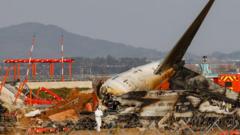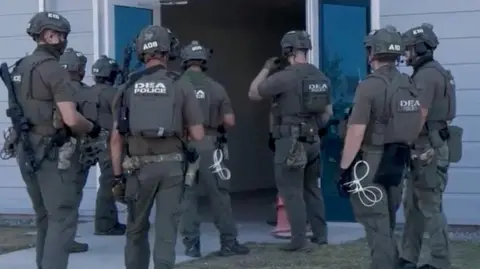The investigation into the tragic Jeju Air plane crash, which occurred last December at Muan International Airport, has taken a contentious turn as the report attributes the calamity largely to pilot error. Local media sources suggest that the pilot mistakenly shut down the functioning left engine instead of the damaged right engine following a bird strike that prompted an emergency landing. The findings, originally set to be released over the weekend, were delayed due to intense public outcry from the victims' families.
All but two of the 181 passengers aboard Flight 2216 lost their lives in this catastrophic incident. Families assert that the report fails to adequately address significant factors that contributed to the severity of the crash. In particular, they point to the concrete barrier at the end of the runway as a critical element that exacerbated the impact upon landing, stating that the report gives an unfair focus to the pilot's decision-making.
Early reports indicated that shortly before the crash, the pilots had reported a bird strike and issued a mayday, attempting a landing from the opposite direction. Eyewitness footage revealed the aircraft making a belly landing without deployed landing gear, resulting in a fatal skid into a concrete barricade.
While preliminary findings from South Korea's Aviation and Railway Accident Investigation Board suggest the decision to switch off the wrong engine was the primary error, families and the Jeju Air pilots' union have raised alarms about a lack of comprehensive investigation into other possibly culpable factors. They demand clarity and transparency from investigators and have called for a detailed briefing post thorough examination of all dimensions related to the crash.
Despite families lodging a criminal complaint against Jeju Air’s CEO for professional negligence, a source involved in the investigation noted that the findings are solidified by robust evidence and are unlikely to be altered. In response to the accident's aftermath, South Korea's transport ministry announced efforts to remove similar concrete barriers at seven airports to prevent future tragedies.
All but two of the 181 passengers aboard Flight 2216 lost their lives in this catastrophic incident. Families assert that the report fails to adequately address significant factors that contributed to the severity of the crash. In particular, they point to the concrete barrier at the end of the runway as a critical element that exacerbated the impact upon landing, stating that the report gives an unfair focus to the pilot's decision-making.
Early reports indicated that shortly before the crash, the pilots had reported a bird strike and issued a mayday, attempting a landing from the opposite direction. Eyewitness footage revealed the aircraft making a belly landing without deployed landing gear, resulting in a fatal skid into a concrete barricade.
While preliminary findings from South Korea's Aviation and Railway Accident Investigation Board suggest the decision to switch off the wrong engine was the primary error, families and the Jeju Air pilots' union have raised alarms about a lack of comprehensive investigation into other possibly culpable factors. They demand clarity and transparency from investigators and have called for a detailed briefing post thorough examination of all dimensions related to the crash.
Despite families lodging a criminal complaint against Jeju Air’s CEO for professional negligence, a source involved in the investigation noted that the findings are solidified by robust evidence and are unlikely to be altered. In response to the accident's aftermath, South Korea's transport ministry announced efforts to remove similar concrete barriers at seven airports to prevent future tragedies.





















